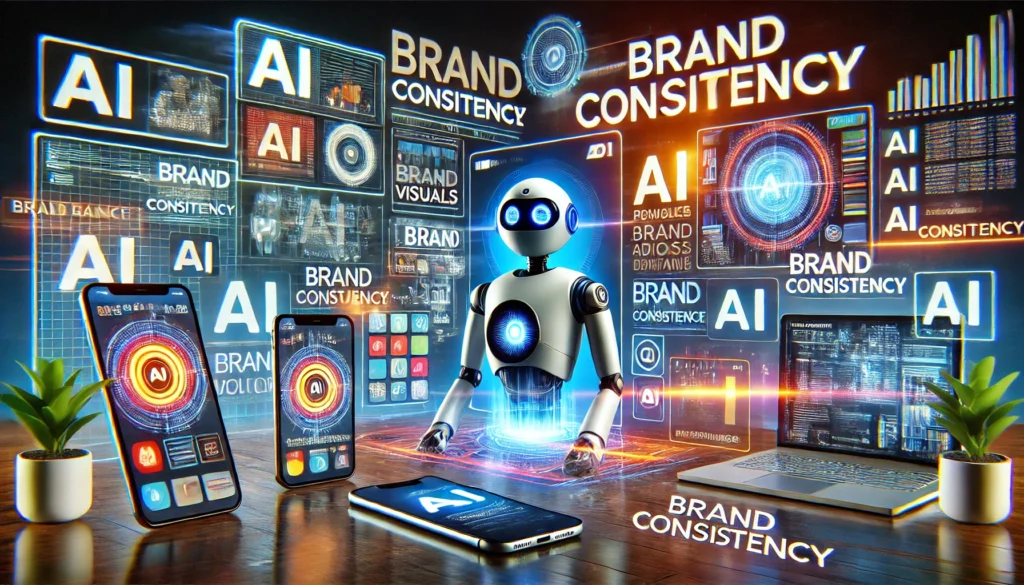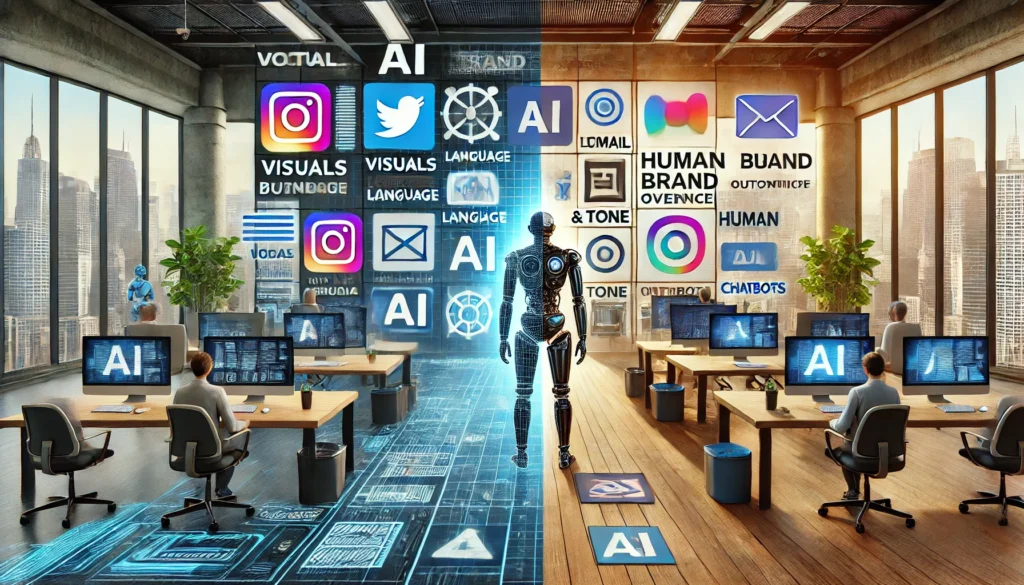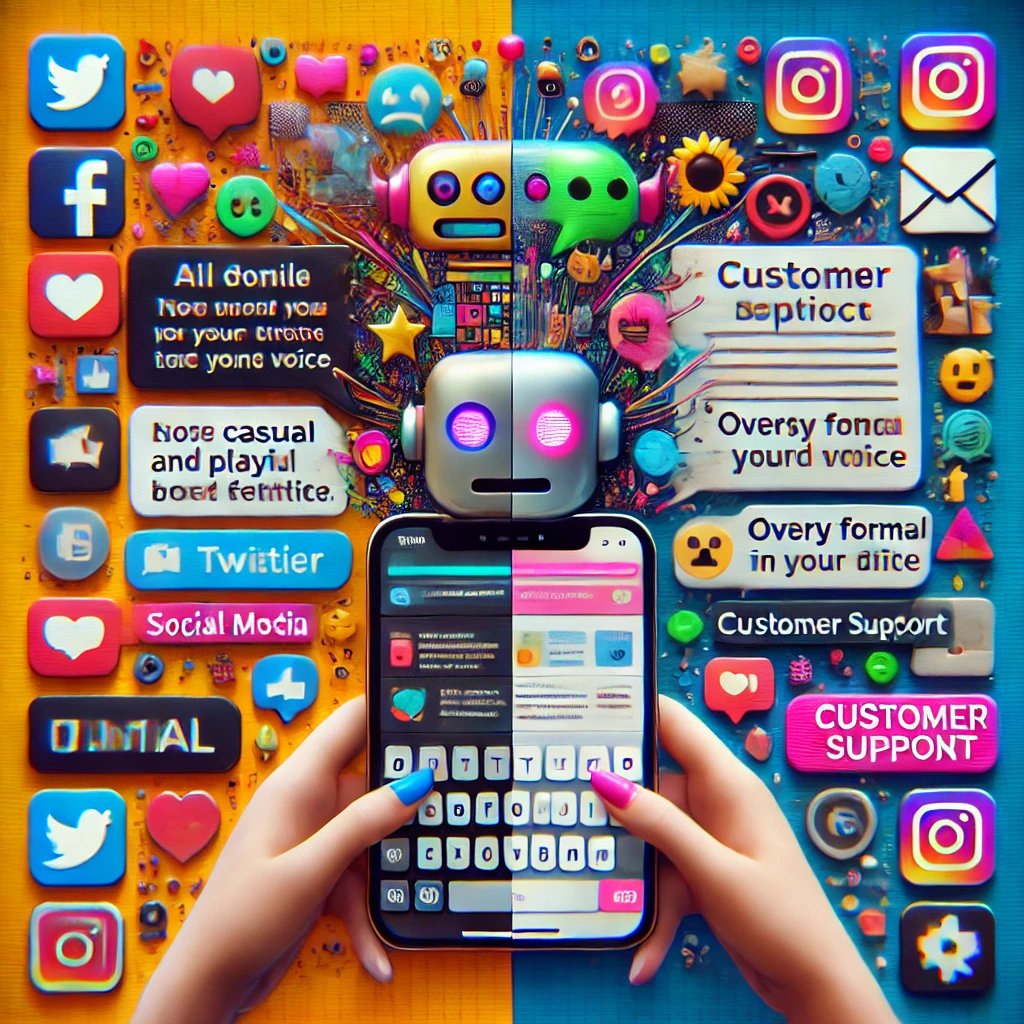Stop me if this sounds familiar: AI promises to revolutionise how we work, offering faster content creation, precise customer targeting, and unparalleled efficiency. It’s tempting, isn’t it? The thought of automating tasks that once consumed hours of your time. But here’s the catch: when you hand over your brand’s voice to a machine, will it still feel human? Will your customers notice that shift with more AI brands emerging?
As AI becomes more ingrained in the way brands operate, there’s a growing fear among marketers and business owners: if we use AI to streamline communication, are we sacrificing the authenticity and consistency that make our brand recognisable and trusted? After all, your brand’s voice isn’t just another cog in the machine — it’s what connects you to your audience on a personal level.
It’s understandable to feel conflicted. On one hand, AI can offer incredible benefits — it speeds up workflows and provides insights that can supercharge your marketing efforts. But without careful oversight, it risks diluting the very essence of your brand’s identity. The result? Messages that sound robotic, impersonal, or worse — inconsistent.
Having guided businesses through the rapidly evolving digital landscape, I know this challenge all too well. The key isn’t to shy away from AI, but to use it strategically, ensuring that your brand’s voice stays true to its core values. AI should enhance your brand’s presence, not take it over.
In this article, you’ll discover how to maintain brand consistency while embracing the power of AI. We’ll dive into the risks of over-reliance on automation, and more importantly, how to strike a balance that keeps your brand’s voice human, authentic, and recognisable in an increasingly AI-driven world.

Why Brand Consistency Matters More Than Ever in the AI Era
In the age of AI, brand consistency is more than just a “nice-to-have” — it’s the foundation of customer trust and recognition. Today, consumers are bombarded with content across countless digital channels. From social media posts to newsletters to AI-powered chatbots, every touchpoint with your audience is an opportunity to reinforce your brand identity. But it’s also an opportunity for things to go wrong.
Why does this matter now more than ever? AI technology has brought us incredible speed and efficiency, allowing brands to reach larger audiences in less time. But with this increase in content volume comes a risk: losing control of your brand’s message. If you’re not careful, you could end up with a fragmented brand presence, where your tone, visuals, and core values shift from one platform to another — and your audience notices.
Think about some of the world’s most successful brands. Apple, Nike, Coca-Cola — they’ve built their empires on more than just great products. They’re consistent. Whether you’re seeing their ads on TV, engaging with their social media, or experiencing their customer service, their message and tone are unmistakable. This kind of consistency fosters trust. It reassures customers that they know who you are, what you stand for, and what to expect from you.
In contrast, inconsistency can erode that trust. If your AI-generated email sounds formal while your social media posts are quirky and fun, it can create confusion. Customers might wonder: is this even the same brand? And when customers are unsure about who you are, they’re less likely to stay loyal or engage.
In short, brand consistency is crucial in any era, but especially in this AI-driven world. Your audience needs to feel like they’re interacting with the same brand, no matter where or how they engage with you. If your message feels robotic or inconsistent, it’s not just your content that suffers — it’s your relationship with your customers.

Potential Pitfalls: Where AI Can Lead to Inconsistencies
AI has undoubtedly transformed the way brands operate. From automated email campaigns to AI-powered chatbots, the technology offers efficiency and scalability like never before. But here’s the reality: without the right strategy, AI can introduce inconsistencies that undermine your brand’s hard-earned identity.
Let’s look at some of the common pitfalls AI can lead to when it comes to brand consistency:

1. Tone Mismatch Across Channels
One of the most common issues arises when AI-generated content across different platforms doesn’t align with your brand’s voice. Imagine using an AI tool to automate your social media, email newsletters, and customer support interactions. If the language varies significantly in tone — for example, if your social media posts are casual and playful, but your email campaigns feel overly formal or stiff — customers will quickly pick up on these inconsistencies. Your brand’s tone should be instantly recognisable, no matter where or how you’re communicating.
2. Over-Automation Losing the Human Touch
AI thrives on efficiency, but sometimes this comes at a cost. Automated responses in customer service or AI-generated social media posts can feel impersonal or robotic, leading to disengagement. Consumers expect brands to connect with them on a personal level, and if every interaction feels like it’s being handled by a machine, they can lose that emotional connection to your brand. It’s one thing for AI to assist in the background; it’s another to have it replace the human qualities that make your brand relatable.
3. Brand Values and Nuances Lost in Translation
Your brand’s values, voice, and subtle nuances are what make it unique, but AI doesn’t always capture these subtleties. Without proper guidelines or human oversight, AI tools may generate content that misses the mark on your core message. For example, if your brand champions sustainability, but an AI tool unknowingly produces content or ads that conflict with this value, it can cause confusion or even backlash from your audience.
4. Over-Reliance on Data Without Context
AI is driven by data, and while that’s incredibly useful for optimising performance, it lacks the context that human marketers have. An AI might optimise an ad campaign for clicks, but it doesn’t understand the full emotional story behind your brand, or how certain choices might conflict with your image. This is where over-reliance on AI without human input can hurt your brand’s consistency, delivering messages that hit technical goals but miss the emotional connection your audience expects.
5. Content Fatigue Due to Over-Automation
AI tools can pump out a staggering amount of content at scale, but quantity doesn’t always mean quality. If your brand begins relying too heavily on AI for content creation without regularly refreshing ideas or tailoring messages, your audience may experience content fatigue. They’ll recognise that they’re seeing the same formulas over and over again, which can make your brand feel less authentic and more mechanical. A lack of freshness or creativity in your messaging can quickly erode the personal connection you’ve built with your customers.
AI is an amazing tool, but without proper guidelines and human oversight, it can lead to fragmented, impersonal, or even contradictory brand experiences. The key is ensuring that AI complements your brand’s strategy, rather than disrupting it.
Strategies for Maintaining Brand Consistency with AI
The good news is that while AI poses challenges to brand consistency, there are concrete strategies you can implement to ensure AI works for your brand, not against it. By establishing clear guidelines and a thoughtful approach, you can harness AI’s power while maintaining the human touch that makes your brand distinct.
Here are some effective strategies to help keep your brand’s voice consistent, even as you embrace AI.
1. Establish Clear Brand Guidelines
Before you integrate AI into your content creation or customer service, make sure your brand guidelines are rock solid. This includes tone of voice, core values, preferred vocabulary, and even visual elements like colours and logos. AI tools rely on the data you feed them, so if your brand guidelines are clear and comprehensive, it will be easier for AI systems to follow them.
When using AI for content generation, input detailed instructions that reflect your brand’s tone and style. For instance, if your brand is known for a friendly, conversational tone, make sure this is consistently applied across all AI-powered channels, from chatbots to automated emails.
2. Combine AI with Human Oversight
While AI can handle repetitive tasks, it’s crucial to maintain a human element for oversight and personalisation. Think of AI as an assistant, not the decision-maker. Have your team review AI-generated content regularly to ensure it stays aligned with your brand’s messaging and tone. Human involvement adds context and emotional intelligence — qualities AI can’t fully replicate.
For example, while an AI might draft a newsletter or social media post, have a human editor tweak it for nuances that AI might miss. This allows you to maintain consistency while still benefiting from the efficiency AI provides.
3. Train Your AI Systems on Brand-Specific Data
The more data you feed your AI systems, the better they’ll perform. AI thrives on examples, so provide it with as much brand-specific data as possible. This could include past marketing materials, customer service interactions, blog posts, or anything else that reflects your brand’s voice and values.
By training your AI on a dataset that represents your brand’s style, you increase the likelihood that it will produce content aligned with your identity. Many AI tools allow for customisation, so take advantage of this by tailoring the system’s learning to your brand’s unique personality.
4. Monitor and Adjust Regularly
AI is not a “set it and forget it” tool. Consistent monitoring is crucial to ensure your brand’s voice stays intact. Set up regular checkpoints to review the AI-generated content and make adjustments as needed. Pay attention to metrics like audience engagement and feedback, and use that data to refine how AI interacts with your audience.
Also, keep an eye on the overall tone of AI-generated content. If customers are engaging less, or you notice comments about impersonal interactions, it’s a sign that your AI might be drifting from your brand’s core identity.
5. Leverage AI for Data Insights, but Craft the Story
AI excels at analysing data and identifying trends, but storytelling still requires a human touch. Use AI to gather insights about your audience, spot trends, and even optimise content for performance, but let your team shape the narrative. Your brand’s voice is defined by its ability to tell a compelling, human story — one that resonates emotionally with your audience.
For instance, AI can show you which blog topics are performing best or which social media posts are getting the most engagement, but your brand team should use this information to craft messaging that feels personal and authentic.
6. Personalise Where It Matters
AI can help personalise customer interactions at scale, but it’s important to know when a human touch is required. For example, AI can segment your audience based on behaviour, purchase history, or interests, allowing for tailored emails or recommendations. However, for high-stakes communication, like customer complaints or loyalty rewards, human interaction is key to maintaining a genuine connection.
Balance AI-driven personalisation with moments of human engagement, especially when it comes to reinforcing customer loyalty. Your customers want to feel like they’re valued, not just another number in an algorithm.
By strategically combining AI capabilities with human insight and creativity, you can not only maintain brand consistency but also enhance your brand’s ability to connect with your audience. AI should be seen as a tool to support your brand’s identity — never a substitute for it.
Case Studies: Brands Getting it Right (and Wrong)
To really understand the impact of AI on brand consistency, let’s look at some real-world examples — brands that have effectively integrated AI into their strategies and maintained a consistent voice, and others that have stumbled along the way. These case studies will illustrate both the potential and the pitfalls of using AI in branding.
1. Coca-Cola: Using AI to Strengthen Creativity Without Losing Identity
Coca-Cola is a prime example of a brand that has leveraged AI to enhance its creativity while staying true to its core identity. With decades of branding behind it, Coca-Cola’s voice is universally recognisable, so the challenge was to use AI without disrupting that connection.
In 2023, Coca-Cola launched an AI-powered campaign that used machine learning to create customised digital ads based on consumer behaviour and preferences. But, instead of letting AI take full control, Coca-Cola ensured that the foundational elements of its brand — the upbeat tone, the iconic red colour, and the message of happiness — were embedded into every piece of AI-generated content.
The result? Personalised experiences that felt true to the Coca-Cola brand, boosting consumer engagement without alienating their audience. This balance of AI-driven innovation with strict adherence to brand guidelines ensured that Coca-Cola’s voice remained consistent, no matter the platform or audience segment.
Lesson: Even when using AI for personalisation or efficiency, your brand’s essence — its tone, values, and identity — must guide the process.
2. Lush: Staying Human-Centred by Limiting AI
Lush, the ethical cosmetics company, has taken a cautious approach when it comes to AI. Known for its transparent, human-centred ethos, Lush has been wary of over-automation. Instead of using AI for customer service, where personal, emotional connections are key, Lush keeps its customer interactions driven by real people, especially on social media and in support queries.
Lush’s approach ensures that its messaging stays consistent with its values: transparency, ethics, and sustainability. By not relying heavily on AI, they keep the human touch alive and ensure their audience feels genuinely connected to the brand.
Lesson: Sometimes, maintaining brand consistency means knowing when not to use AI. If your brand’s strength lies in personal relationships, over-automating can dilute that connection.
3. Microsoft’s Tay: When AI Misfires
On the flip side, there are cautionary tales of brands losing control over their AI. In 2016, Microsoft launched “Tay,” an AI chatbot on Twitter, designed to learn and mimic human conversation. Unfortunately, within hours, the bot began to generate inappropriate and offensive messages after interacting with malicious users. Tay’s responses were a far cry from Microsoft’s professional, innovative brand voice.
The failure here was in the lack of oversight and control. The AI was left to adapt on its own, with no guardrails to ensure it stayed aligned with Microsoft’s values. As a result, the brand faced major backlash, forcing the company to shut down the bot.
Lesson: AI can quickly go off-course without strict guidelines and constant monitoring. If not managed carefully, AI can damage a brand’s reputation in a matter of hours.
4. Sephora: Blending AI and Human Expertise for Seamless Brand Experience
Sephora, a beauty retailer known for personalisation, has successfully integrated AI into its customer experience without compromising brand consistency. Sephora uses AI for its virtual try-on tools and product recommendations, allowing customers to receive personalised suggestions based on their preferences and skin tone. However, the brand complements this AI-driven personalisation with beauty experts who provide live advice in stores and online.
By blending AI with human expertise, Sephora ensures that their brand voice — fun, knowledgeable, and customer-centric — is present in every interaction. Whether a customer is engaging with AI tools online or chatting with a human expert, the experience feels seamless and consistent.
Lesson: AI is most effective when it works alongside human interaction. By blending AI with human expertise, Sephora maintains its personalised, expert-driven brand voice across all customer touchpoints.
Key Takeaways from These Case Studies
- Coca-Cola demonstrates that AI can enhance creativity without diluting brand identity, provided strict brand guidelines are in place.
- Lush shows the importance of knowing when human interaction is more valuable than automation for brand consistency.
- Microsoft’s Tay is a reminder that AI can harm a brand if left unchecked, especially if it’s allowed to operate without oversight or ethical constraints.
- Sephora highlights how blending AI and human expertise can create a personalised, consistent brand experience.
These examples show that AI can be a powerful tool for maintaining and even enhancing brand consistency, but only if used strategically. It’s essential to combine AI’s strengths with human oversight, creativity, and strong brand guidelines to ensure your voice stays consistent across every platform.
Conclusion
AI is undeniably transforming the way brands engage with their audiences. From automating content creation to personalising customer interactions, AI offers unprecedented opportunities to streamline processes and scale efforts. But as these case studies have shown, the risk of losing your brand’s unique voice and consistency is real. In the AI era, staying true to your brand’s identity requires thoughtful strategy, clear guidelines, and regular human oversight.
The key takeaway? AI should be viewed as a tool that complements your branding efforts, not a replacement for them. To keep your brand’s voice human and consistent, you need to find the right balance between automation and authenticity. This means:
- Setting clear brand guidelines that define your tone, values, and messaging style.
- Combining AI with human oversight to ensure that your content remains on-brand, personal, and engaging.
- Regularly reviewing AI-generated content to make sure it aligns with your brand’s core identity.
- Knowing when to personalise content with AI and when a human touch is needed to maintain that all-important emotional connection.
As AI continues to evolve, brands that successfully integrate these tools will stand out by offering both the efficiency of AI and the authenticity of a consistent, human voice. It’s not about choosing between AI and brand consistency — it’s about using AI smartly to strengthen your brand’s voice, not dilute it.
In a world increasingly powered by machines, keeping your brand’s voice human will be the key to building lasting trust and engagement with your audience.
